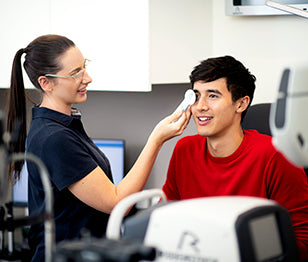All about myopia (or short-sightedness)

Myopia is a common vision problem you’ll likely have heard of. It’s also known as short-sightedness, meaning it can be difficult to see things in the distance. Things like road signs (especially at night) might be tougher to make out, but reading a book might be fine.
It’s not actually a disease but a refractive error. That means the eye doesn’t bend light properly, which affects how our eyes focus on longer distances. Around 50% of Australians experience these symptoms.
What will I experience if I have it?
It may be struggling to read something far off or you might notice kids sitting too close to the TV. Either way, myopia can also cause:
- Headaches
- Eye strain
- Eye fatigue
- Squinting
What’s the medical explanation?
Myopia / short-sightedness is a structural problem in the eye where there’s too much of a curve in the cornea or crystalline lens - or the eyeball is too long. This means light focuses in front of the retina in the back of the eye, instead of directly onto it, making objects in the distance appear blurry.
It’s not totally clear what the underlying cause is, but research suggests short-sightedness runs in the family. It’s also interesting to note that spending too much time inside or focused on objects up close (like books, screens, etc) can be a contributing factor.
What does vision with myopia look like?
Click and drag the image below to see how myopia can affect your vision.
Healthy vision
How is myopia diagnosed?
It’s actually a pretty straightforward eye test that lets your optometrist know if you’ve got myopia symptoms. Using an eye chart, your visual acuity will be checked – and other instruments can pick up if someone’s short or long-sighted.
It’s often picked up in childhood, but if it’s not treated it tends to get worse until after the teenage years – that’s why early detection is really important. The good news is that there are strategies that can significantly reduce the rate and degree of deterioration.
Treating myopia
There’s no cure for myopia, but glasses or contact lenses can correct your vision. It’s important to get in as early as possible. Once it’s stabilised, laser eye surgery can be an effective way to correct your vision. Of course, there are no guarantees, but a tailored management plan (taking into account your age, prescriptions and lifestyle needs) with your optometrist can really help reduce the speed or severity of vision problems.
Some common treatment paths include: distance-centre multifocal contact lenses, atropine eye drops, bifocal or multifocal glasses, or orthokeratology (which entails the wearing of rigid contact lenses while you sleep to help reshape the cornea).
Keep having regular eye tests - it’s also important to ensure you don’t develop complications like glaucoma, cataracts or other eye conditions.

We're here to help
Ask your optometrist if you have any questions about myopia or book an appointment today.
You might also like to read...
View all-
Understanding astigmatism
There’s a good chance you’ve heard of astigmatism before. It’s a common eye condition that causes blurred vision, discomfort in your eyes and headaches.
Eye conditionsUnderstanding astigmatism
There’s a good chance you’ve heard of astigmatism before. It’s a common eye condition that causes blurred vision, discomfort in your eyes and headaches.
Read more -
Learning more about cataracts
You’ve probably heard of cataracts – when the normally clear lens of the eye becomes cloudy. It happens because the lens becomes hardened, and it means a gradual decrease in...
Eye conditionsLearning more about cataracts
You’ve probably heard of cataracts – when the normally clear lens of the eye becomes cloudy. It happens because the lens becomes hardened, and it means a gradual decrease in...
Read more -
The ins and outs of colour deficiency
You might know colour deficiency by its other name – colour blindness. This name isn’t technically correct, as most people living with colour deficiency can actually still see colours.
Eye conditionsThe ins and outs of colour deficiency
You might know colour deficiency by its other name – colour blindness. This name isn’t technically correct, as most people living with colour deficiency can actually still see colours.
Read more





